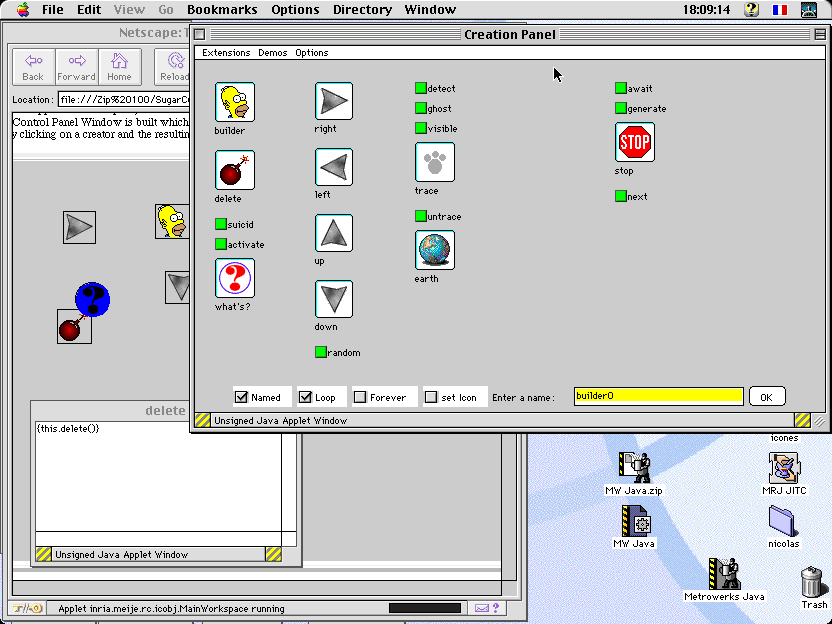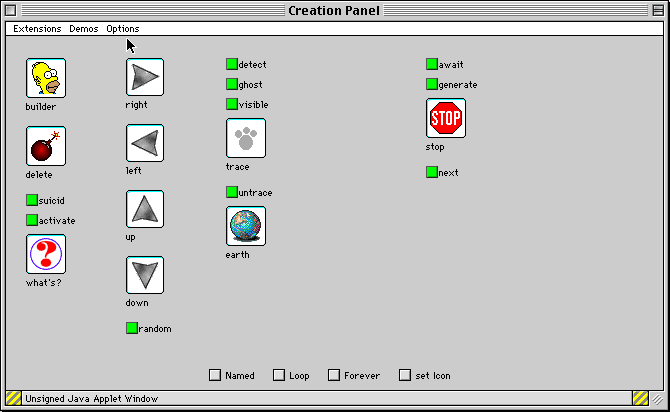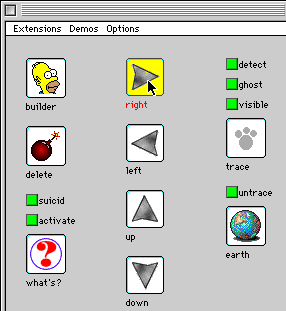The WeIcobj Demo (Mars 1999)
Icobj Programming on the Web
Welcome on the WEB-ICOBJ Page !

WEB-ICOBJ 1.0 is now available;
Click here to execute the demo:
Démo v1.0
for
Netscape
for
Internet Explorer
for
other Web-browsers
Presentation
WEB-ICOBJ adapts Icobj Programming to the Web. Icobjs provide an extremely simple and intuitive graphical interface for programming over Internet and for building behaviors (for animations, agents, robots, etc.) without writing any code line. They are particularly well suited for combinations of small behaviors to get complex scenarios.
Introduction
Generally, graphical programming systems provide graphical representations of a programming language syntax. On the opposite, Icobjs give the user the way to combine elementary behaviors in order to get more complex ones, without any reference to syntax. Actally, Icobjs are animated graphical objects (icons) having an influence area to interact with other icobjs present in it. In general, the influence area of an icobj is its graphical representation. Icobjs own specific reactive behaviors and can communicate by broadcast events. Please note that there are actually two ways for Icobjs to communicate: a local graphical way by influence areas, and a global remote way by broadcast events. Icobjs are implemented with Reactive Scripts, which give them a precise semantics. A complete description of Reactive Scripts and of the reactive paradigm can be found at http://www.inria.fr/meije/rc.
The key point of Icobj Programming is the possibility to combine elementary behaviors in a simple way, in order to get more complex ones. For example, suppose that there exists two elementary behaviors: the first one to find informations using a search engine; the other one which terminates when a time delay is over. By combining these two behaviors, one can build a more complex one, which starts a search but stops it if it takes too much time. Using Icobjs, users have an intuitive way to combine behaviors (to put them in sequence or in parallel, to make them loop, to control them, etc.) and can build small programs without real knowledge of programming. Thus, starting for a minimal set of elementary behaviors, one easily gets small, flexible, and reusable components.
The simplicity of behavior combinations comes from the graphical means provided to express parallelism and sequencing. The user can put in parallel several elementary behaviors by one simple click in a builder whose influence area overlaps them. In the same way, one gets a sequence of behaviors by successively moving a builder over them and by clicking on it. See a more precise description of this mechanism below (in definition of the "builder" Icobj).
In this document, we describe the architecture of WEB-ICOBJ, then give the bases of Icobj programming with several elementary behaviors used in the demo.
The WEB-ICOBJInterface
WEB-ICOBJ is an applet with an embedded reactive interpretor. This reflects the two basic aspects of the system: the graphical aspect provided by the Java applet (more specifically, by Awt), and the behavioral aspect provided by the reactive engine.
The Icobj graphical environment is made of two components: the "Workspace" where Icobjs are moving, and the "Creation Panel" which contains a set of Icobjs called creators. By clicking on a creator, the user starts a new Icobj building phase. The new Icobj will be created in the Workspace.

 When the user moves the mouse cursor on a hot point in the Creation
Panel,
the colour of the corresponding creator changes. The creation procedure
of a new Icobj in the
Workspace starts when
a creator is clicked in. This procedure can be more or less complex and
it can possibly need some others existing Icobjs
whose behaviors are cloned to be reused, or some auxiliary Icobjs.
When the user moves the mouse cursor on a hot point in the Creation
Panel,
the colour of the corresponding creator changes. The creation procedure
of a new Icobj in the
Workspace starts when
a creator is clicked in. This procedure can be more or less complex and
it can possibly need some others existing Icobjs
whose behaviors are cloned to be reused, or some auxiliary Icobjs.
The builder Icobj
is used to define new Icobjs
by combining (parallelism, sequence, loop, ...) existing Icobjs
in the Workspace.
![]()
This process can need some extra parameters that the user must provide in a special area, at the bottom of the Creation Panel. These informations are supplied with three check-buttons and a dialog text area.
Once the building phase finished, the new Icobj appears in the Workspace, waiting the first activation to start execution of its behavior. The Icobj color turns to red on activation to indicate that it starts to execute. When the behavior terminates, the Icobj color turns to blue; the Icobj is then inactive and does not respond to further activations.
Some Icobjs can be activated several times during their life-time, as it is the case for the planet Icobj below which increases its attraction area each time it is clicked in (beware that the attraction area does not correspond to the planet icon).
An Icobj which has terminated its behavior becomes inactive, but this does not means that it is useless: its behavior can still be used and cloned to build new Icobjs.
Icobjs in the Workspace can be moved with the mouse while the "Shift" key is down (or with the right mouse button, with Windows or X-Window). In the same way, the size of an Icobj can be changed with the mouse while the "Control" key is down (or with the middle button, with X-Window).
Some basic behaviors
Icobjs are implemented with Reactive Scripts. Actually, an Icobj behavior is a reactive script whose extern actions, between brackets, are method calls of Java objects. The interface with Java is presently very primitive: a small interpretor associates actual Java calls to external statements. As example:
loop {Out.print("coucou")} endwrites coucou on the output referenced by the Out Java object.
We now describe the main Icobjs implemented in WEB-ICOBJ.
- Icobjs Up, Down, Left, Right: these are the very basic Icobjs for creating small animations. They move ten steps (10 pixels) in one of the four directions. The script of Right is:
- Icobj Random combines the previous Icobjs. It randomly choses a direction and moves accordingly:
- The builder Icobj is of particular importance as it builds new behaviors. Activation of the builder creator in the Creation Panel creates an auxiliary builder Icobj in the Workspace. As any other Icobj in the Workspace, the auxiliary builder can be moved or resized. However, activation has a special meaning for it: each time it is clicked in, it performs the following step:
- it copies the behaviors of all the Icobjs present in its influence area;
- it puts in parallel all the copied behaviors;
- it produces a beep to indicate that the step is performed.
- The bomb Icobj destroys all the Icobjs that are present in its influence zone (including itself). It is particularly useful to clean the Workspace !
- Once activated, the detect Icobj terminates as soon as its influence area is not empty (with the exception of ghosts which are undetectable; see next item).
- Icobj ghost cannot be detected by a detect Icobj.
- The activ Icobj activates all the Icobjs present in its influence area, as if the user had simultaneously clicked in all these Icobjs.
- The suicid Icobj terminates instantaneously and vanishes out of the Workspace.
- The What is it? Icobj displays in a new window the reactive script associated to the Icobjs that are present in its influence area upon activation.
- The earth Icobj attracts all the Icobjs present in its attraction area, the size of which can be increased by clicking in it.
- The trace Icobj (resp. untrace) activates (resp. desactives) the tracing mode in which an Icobj leaves a trace behind it when moving.
- loop {10} times {this.translate(10,0)};next;stop end
{Random.set()};
if{Random.equals(0)} then
loop {10} times {this.translate(-10,0)};next;stop end
else
if {Random.equals(1)} then
loop {10} times {this.translate(10,0)};next;stop end
else
if {Random.equals(2)} then
loop {10} times {this.translate(0,10)};next;stop end
else
if {Random.equals(3)} then
loop {10} times {this.translate(0,-10)};next;stop end
end
end
end
end
Example :
Suppose there are two Icobjs Right and Down in the Workspace. A builder is created, so an auxiliary builder appears in the Workspace. Let us place, and resize if necessary, the auxiliary builder so that its influence area overlaps Right and Down. Let us click a first time in the auxiliary builder to get a behavior which combines Right and Down in parallel. Then, let us terminate the building by moving the auxiliary builder so that its influence area is empty, and by clicking in it. A new Icobj is then created which moves in diagonal when activated. In the same way, one gets a circle by combining an horizontal sinusoidal move with a vertical one, out of phase ¹/2 with the first.
The previous construction can be encapsulated in a loop by switching on the looping check-button, before clicking in the builder, in the Creation Panel. The loop is infinite if the forever check-button is on; otherwise, the number of cycles must be entered by the user in the dialog box created for this purpose.
Finally, it is possible to give a name to the new Icobj when the named check-button is on. The user then must enter a name in the dialog box created for this purpose. Moreover, a behavior with this name is also defined in the interpretor, which can be used by the run commands of the Language extension (see below).
- {this.delete()}
- loop if {this.detect()} then break end;stop end
- {this.activateOverlapingIcobj()}
- {this.dispose()}
- {this.displayBehavior()}
- loop {this.attract()};next;stop end
||
loop await {this.getName()};{this.influenceZoneGrows(10,10)};stop end
Extensions
The Extensions menu in the Creation Panel provides some new Icobjs and some demos to use them. When the user choses a package in the menu, several new creators appear in the Creation Panel and some Icobjs are installed in the Workspace. Here is the description of some extensions.
- The Language package: it provides access to reactive scripts through a set of new Icobjs whose semantics are the corresponding reactive scripts primitives.
- The generate and await Icobjs ask the user for an event name to be entered in the bottom of the Creation Panel. On activation, the await Icobj waits for the associated event to be generated by the generateIcobj and then terminates.
- The DoUntil and EventIn constructors are very similar to the builderIcobj except that the behavior obtained is encapsulated in a do until or event in statement. To that purpose, an event name is asked to the user.
- The Stop and Next Icobs are used for precise control over instants of reactive scripts. Their semantics are the ones of the corresponding statements of reactive scripts.
- The Sinus/Cosinus package provides two new Icobs: one draws a sinusoidal move over the horizontal axis, and the other draws a cosinus move over the vertical axis. Combining these two Icobs in parallel draws a circle ! Please remark that this is true only because of the underlying reactive paradigm on which Icobj programming is based; without it, nothing would prevent the two behaviors to run at their own pace, drawing something that certainly would not be a circle.
Remark: to show that events are broadcast, one can create several awaitIcobjs, all awaiting the same event. All these Icobjs terminate simultaneously as soon as the event is generated by a generateIcobj.
A DoUntil Icobj implements preemption: it terminates execution of its body as soon as the preemption event is generated.
A EventIn Icob declares a local event in its body.
Implementation with Reactive Scripts
A demo of Icobj Programming in Java is available. It is implemented with the reactive scripts interpretor rsi-java built with SUGARCUBESwhich is a set of Java classes for the reactive paradigm.
This product is developed in the MEIJE project, common to INRIA and CMA (Ecole Nationale des Mines de Paris), in collaboration with the Soft Mountain and France Telecom companies.
Jean-Ferdy Susini, Inria CMA/Meije, BP 93, 2004 route des Lucioles, 06902 Sophia Antipolis, France. <Jean-Ferdinand.Susini@sophia.inria.fr>